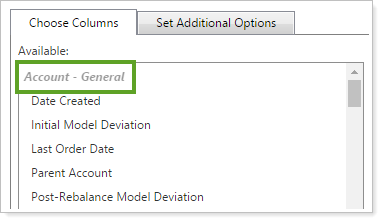Contents
Introduction
Bulk reports are custom comma-delimited reports that you can build using data found in Advisor Rebalancing. You can customize the columns within bulk reports, as well as share them with colleagues. Then, when you run a bulk report, you can see the data from Advisor Rebalancing using your bulk report parameters.
Running Bulk Reports
Once you've built and customized your bulk reports, you can run your bulk reports at any time on the Bulk Reports page. This will run the report on all applicable accounts.

You can run bulk reports on several pages throughout Advisor Rebalancing. This method allows you to run bulk reports on selected accounts rather than all accounts. This can greatly reduce the amount of time needed to generate the report.
Bulk reports usually open in a spreadsheet program like Excel.

Note
It's best to view bulk reports in Microsoft Excel or in a similar spreadsheet program. However, if you do not have Microsoft Excel or another spreadsheet program installed on your computer, you can view reports in Notepad.
For instructions on running bulk reports, see Create, Edit, and Delete Bulk Reports.
Available Bulk Reports
There are two types of reports in the Report Type list: standard report types and upload format report types.
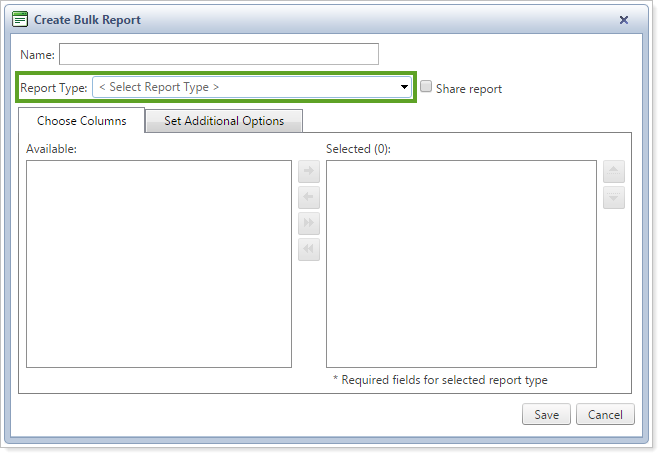
Upload report types are bulk reports where columns are formatted to so that they can be uploaded back into Advisor Rebalancing. This allows you to download a bulk report, update fields in bulk, and re-upload the report back into Advisor Rebalancing. See Upload Format for more information.
Below are descriptions and available data for the bulk reports you can run in Advisor Rebalancing.
Standard Format
Standard format bulk reports are available by choosing Bulk Reports on the Reports menu.
| Report Type | Available Sections | More Information | ||
|---|---|---|---|---|
| Account Information |
|
Includes account settings data for your accounts. Use to audit account settings or account information. |
||
| Account Keywords |
|
Includes keywords associates with your accounts. Use to audit account keywords and find accounts associated with certain keywords. |
||
| Account Model Allocation |
|
Includes account allocations to Security Level models in an Allocation model. Depending on your model setup, this can show you asset class allocation. Use for analysis of accounts before and/or after a rebalance. |
||
| Account Notes |
|
Includes all notes associated with an account. Use to audit account activity and trading information. |
||
| Account Security Information |
|
Includes information about the specific security holdings within a client’s account. You can use this report to show full N-tier model details by selecting the Include model-level detail check box when generating this report. Use to review account holdings information. |
||
| Account Security Restrictions |
|
Includes security restrictions within individual accounts. Use to audit individual account security restrictions. |
||
| Block Trades |
|
Includes individual security targets in Allocation models. Use to analyze accounts after a rebalance. |
||
| Custom Security Settings |
|
Includes the customized information you’ve set for individual securities. Use to review individual securities and their customized settings. |
||
| Fee Schedules |
|
Includes details about the fee schedules you've set up. Use to review fees. |
||
| Model Security |
|
Includes allocations to securities in an Allocation mode. Use to analyze your models. |
||
| Models |
|
Includes detailed information about models and their weights. Use to analyze your models. |
||
| OMS Allocations |
|
Includes allocations generated in trades on the Advisor OMS system. Use for trade analysis and auditing. |
||
| OMS Orders |
|
Includes the orders generated in the Advisor OMS system. Use for trade analysis and auditing. |
||
| Rebalance Messages |
|
Includes messages, warnings, and errors on initial accounts and post-rebalance accounts. Use for account analysis and error handling. |
||
| Restriction Overrides |
|
Includes a list of overrides generated by users in Advisor Rebalancing. Use to audit account activity. |
||
| Security Information |
|
Includes a list of and information about individual securities. This includes data like asset class and security type. Use to review individual securities. |
||
| Security Type Mapping |
|
Includes a list of an information about securities as they've been mapped within Advisor Rebalancing. Use to review individual securities. |
||
| Trades on Hold |
|
Includes all trades on hold for each account. Use to review individual securities and take action on trades placed on hold. |
Upload Format
Upload format bulk reports are available by choosing Bulk Reports on the Reports menu.
Upload format bulk reports have columns formatted to be re-uploaded back into Advisor Rebalancing. This is ideal for situations where you want to change the data for existing accounts or models, using this workflow:
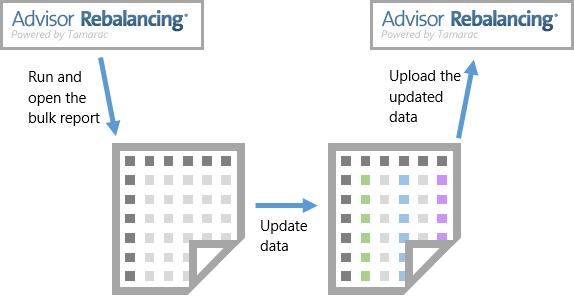
-
Bulk report. Generate and run a bulk report using the columns you choose in the upload report format. Download the report and open it in your spreadsheet program.
-
Update data. In your spreadsheet program, update the fields that require update.
-
Upload. Upload the updated data from your spreadsheet back into Advisor Rebalancing on the Upload page.
| Bulk Report Type | When to Use | Read More |
|---|---|---|
| Account Alternate Security Sets |
Define alternate security sets in individual accounts; alternate security sets allow you to maintain fewer models by creating different Security Level models to assign to different account types. |
Create, Edit, and Delete Security Level Models |
| Account Information |
Create or change specific account information by upload. You can also create new accounts using this upload |
Create and Delete Accounts and Make Changes to Account Settings |
| Account Keywords |
Add keywords to specific accounts. Keywords can be any word or words you want to use to label the account; you can use saved searches to find accounts with specific keywords. |
|
| Account Security Restrictions |
Add security restrictions to the individual accounts you specify. |
|
| Account Security Restrictions Range to Hold |
Add security restrictions to the individual accounts you specify. This upload works in conjunction with the Account Security Restrictions upload though, because the uploads won't always have a one-to-one relationship, this is a separate upload data set. |
|
| Allocation Model Members |
Add submodels to an existing Allocation model and specify model details such as rank and min/max values. NotesWhen creating Allocation models by upload, use the following order:
The upload may fail in the following instances:
|
|
| Alternate Security Sets |
Create new alternate security sets and specify additional details such as rank and min/max values. Alternate security sets allow you to maintain fewer models by creating different Security Level models to assign to different account types. |
|
| Cash Reserves |
Create cash reserves in the individual accounts you specify. You can also use this upload to update time-bound cash reserves. For example, you can identify RMD clients using a saved search, then use that saved search to generate the Cash Reserves (upload format) bulk report. You can then update the start date to the next year, then upload that data back into Advisor Rebalancing. |
|
| Custom Input Symbols |
Map securities to a custom symbol you specify; this allows you to take an unrecognized symbol that exists in your portfolio accounting system (PAS) and map that symbol to an alternate symbol in Advisor Rebalancing. NoteThe CustomInput field is the unknown security that you want to map the existing tickers to. The specific fields in this upload are available in Data Specifications. |
Security Mapping |
| Custom Security Settings |
Establish custom settings for individual securities, like custom trade price or custom round lot. |
Securities Custom Settings |
| Industry Group Restrictions |
Create industry group restrictions in individual accounts. |
Industry Group Restrictions Setting |
| Model Priorities |
After establishing asset location preference labels, you can use this data set to create model priorities for those asset location preference labels. |
Set Model Priorities |
| Rebalancing Groups |
Create the names of rebalancing groups. NoteWhen creating rebalancing groups by upload, use the following order:
|
Create, Edit, and Delete Rebalancing Groups |
| Securities in Security Level Model |
Add securities to an existing Security Level model and specify model details such as rank and min/max values. NotesWhen creating Security Level models by upload, use the following order:
The upload may fail in the following instances:
|
Create, Edit, and Delete Security Level Models |
| Substitute Securities |
Create global substitute securities. |
Security Substitutes |
| Trade Group Security Settings |
Configure trade file group settings for individual securities, allowing you to customize trade files. |
Trade File Group Settings |
| Underlying Accounts for Rebalancing Groups |
Add accounts to an existing rebalancing group name. NoteWhen creating rebalancing groups by upload, use the following order:
|
Create, Edit, and Delete Rebalancing Groups |
Reconciliation Reports
Like bulk reports, reconciliation reports are downloadable reports listing various reconciliation data by account. You can access reconciliation reports by clicking Reconciliation Reports on the Reports menu.
For more information on available reconciliation reports, see Reconciliation Reports.
Account Trade Report
The Account Trade Report is the default trade report for compliance and recordkeeping. It extends the reporting functions of the Compliance Trade List report and Detailed Generic Trade List reports. If the default Account Trade report doesn't meet all the compliance and reporting needs, as a best practice, you should use the Account Trade report as a starting point and customize it to meet your firm's requirements.
For more information, see Trade List and Creating Trades.
Export Column Metadata
To view the available columns for each bulk report type, you can use the Export Column Metadata link. When you export column metadata, you can download a spreadsheet list of available columns for the report type you select.
To export column metadata, follow these steps:
-
On the Reports menu, click Bulk Reports.
-
Click Create Report.
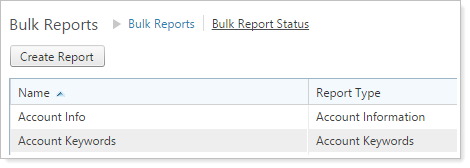
-
Choose the report type you want to view column metadata for in the Report Type list.
-
On the Set Additional Options tab, click Export Column Metadata.
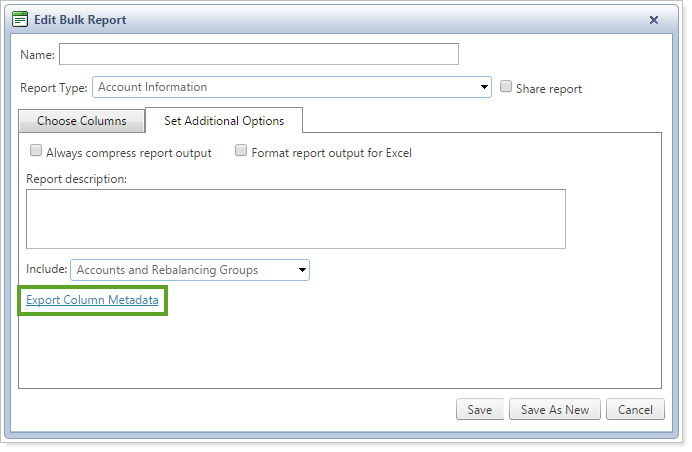
You'll be prompted to open or download a CSV file containing the column metadata for your chosen report type. This file will tell you the following information:
-
Report Type Internal Name: the internal name for the report in which the columns appear.
-
Column Internal Name: the internal name for the column. This differs from the Column Display Name because the display name is more user friendly. For example, the internal is AccountNumber while the display name is Account Number.
-
Is Custom Field: shows if the column data is based on a custom field.
-
Column Display Name: the column name that will appear when you run and then download the bulk report.
-
Section Display Name: the bulk report section in which you can find that column. For example, Account - General data.
